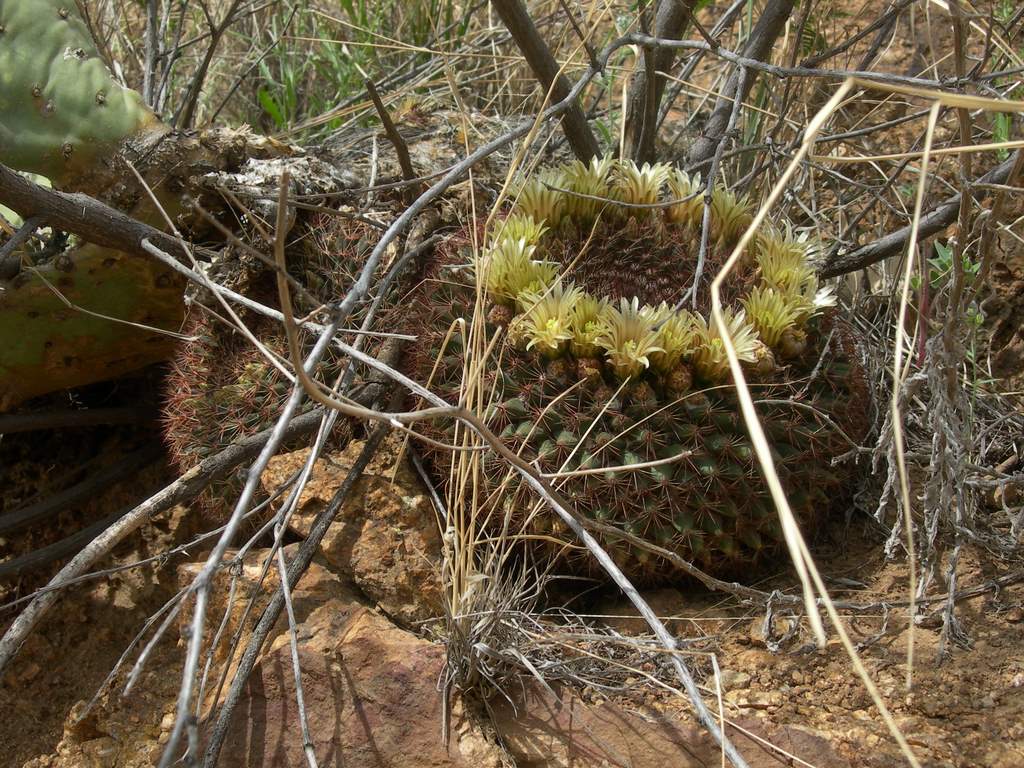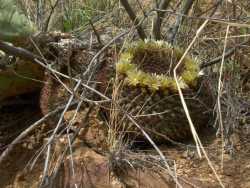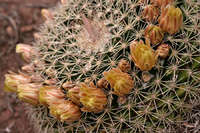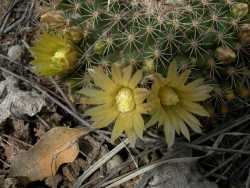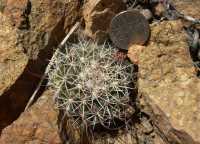Plants unbranched, deeply seated in substrate. Roots short, obconic taproots; secondary roots diffuse. Stems usually flat-topped (in old age or under dense brush hemispheric), 4-20 × 9-25(-30) cm, firm; tubercles 10-17 × 6-8.5 mm; axils woolly, wool 5-8 mm, bristles absent; cortex and pith not mucilaginous; latex sticky white, abundant in healthy tissue throughout cortex of stem, tubercles, and sometimes flower receptacles. Spines 11-14(-16) per areole, white to straw yellow, glabrous; radial spines 10-12 per areole, whitish to pale yellowish tan , needlelike, 20 mm, stiff; central spines 1-2(-4) per areole, ± porrect or 1 ascending and 1 descending, straight or slightly curved, 10 mm; subcentral spines 0. Flowers 3-4 × 2.5-3.5 cm; outermost tepal margins densely minutely fimbriate (at 10×); inner tepals greenish white to greenish yellow, 14-17(-25) × 2-3 mm; stigma lobes yellow-green to pale green, 2-3 mm. Fruits whitish green proximally, pale green distally with pale rose-purple on sunlit portions, obovoid to clavate, 15-26 × 7.5-15 mm, juicy only in fruit walls; floral remnant persistent. Seeds reddish brown or orange, 1.1-1.3 × 0.9 × 0.8 mm, pitted; testa intermediate, anticlinal cell walls undulate, interstices much narrower than pit diam., pits deeply concave, elongate. 2n = 22.
Flowering Mar-May; fruiting Oct-Mar. Rocky slopes and ridges, ecotone between Sonoran desert scrub and chaparral, oak woodlands, grasslands; 1100-1800 m; Ariz.; Mexico (Sonora).
Mammillaria macdougalii is the characteristic flat-topped mammillaria of the mountains near Tucson and Nogales, Arizona. Records from farther east are all (insofar as can be determined) misidentifications of M. heyderi var. bullingtoniana.
Common Name: Macdougal's nipple cactus
Duration: Perennial
Protected Status: Salvage restriced status in Arizona.
General: Unbranched plants that are partially in the ground with short roots and flat topped stems (these can be hemispheric in old age or under brush) that are 4-20 cm tall and 9-25 cm wide, the stems are firm with tubercles 10-17 mm long by 6-8.5 mm wide and axils that are woolly, the wool 5-8 mm, there is usually a milky white and sticky latex.
Spines: Spines 11-14 and white to straw yellow and glabrous, the 10-12 radial spines include those on lower side of areole which are elongate and whitish to pale yellowish tan and stiffly needlelike reaching 20 mm, the 1-2 central spines are brown to reddish-brown or tan, straight or slightly curved and reach 10 mm.
Flowers: Overall 3-4 cm long and 2.5-3.5 cm diameter with the outermost tepal margins minutely fimbriate while the inner tepals are greenish white to yellowish and linear-lanceolate, 14-17 mm long by 2-3 mm wide, the stigma lobes are yellow green to pale green and 2-3 mm.
Fruits: Whitish green below and pale green above with pale rose purple on sunlit portions, the tepals are red when mature and obovoid to clavate about 15-26 mm long by 7.5-15 mm and juicy only in fruit walls.
Ecology: Found on rocky slopes and along ridges often in Sonoran desert scrub, chaparral, woodlands, and grasslands from 3,500-6,000 ft (1067-1829 m); flowers October-March.
Notes: Considered rare in most counties in Arizona. Can be found along the margins of the Sonoran Desert scrub, in the chaparral and oak woodlands, and desert grasslands. FNA designates this as its own species, while ITIS and Plants DB continue to refer to this species as M. heyderi var. macdougalii.
Ethnobotany: Unknown
Etymology: Mammillaria from the Latin mammilla, a nipple, while macdougalii is named for Daniel Trembly MacDougal (1865 1958), the first director of the Desert Laboratory in Tucson.
Synonyms: Mammillaria heyderi var. macdougalii
Editor: SBuckley, 2010


